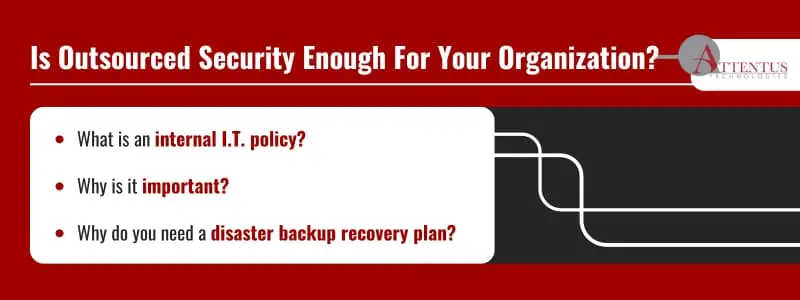For forward-thinking SMBs, a solid internal policy is also a must-have. Here’s what you need to know about outsourced I.T. and how it can help your team achieve its goals.

You outsourced I.T. management to the best team you could find. Is that all your business needs to stay secure?
Sure, they bring the technology, tools, and expertise to continuously monitor your network, prevent hacking, block threats, contain malware, rapidly respond, and recover from incidents. But will that stop an uninformed employee from inadvertently putting the company at risk of a breach?
What if there was more you could do to elevate your security posture?
A written internal I.T. policy outlining your stance on security—the do’s and don’ts for employees—can help you maximize the value of your managed service provider (MSP).
Here’s what you should know.
What’s an Internal I.T. Policy?
Would you agree that I.T. is everyone’s responsibility? Do you have a written internal I.T. policy?
An internal policy is a high-level document that identifies the rules for all individuals using your organization’s assets and resources and how they access them.
It contains:
- Objectives
- Scope
- Goals
- Responsibilities for I.T. security and compliance
- Sanctions for intentional policy violations
Notably, it’s a living, breathing document updated regularly based on business I.T. requirements and compliance changes.
Without an internal policy, how will you ensure confidentiality, integrity, and availability of system information?
Your internal policy should outline the rules of the road for employees. It should mitigate security risks by setting standards about:
- How things should be done
- What the requirements are
- How to perform these duties
- Who does what, when, where, and why
- What the penalties are for breaking the rules
This last part is essential for ensuring staff understand that there will be repercussions for violating the policy.
When you have a solid policy and straightforward procedures, you have an explanation of why you’re doing what you’re doing, who’s responsible for doing it, and a consistent way of performing. That, in and of itself, will strengthen your security posture because you don’t have 20 different people doing things 20 different ways and possibly raising the risk of a breach.
Developing an internal policy can be daunting, considering the many moving parts. I have security best practices baked in, plus cover compliance with the various regulations you are subject to. This could be the Safeguard’s Rule for financial institutions, the Health Insurance Portability and Accountability Act (HIPAA) for healthcare, and the General Data Protection Regulation (GDPR) for those operating in the European Union (EU), among others.
A reliable partner can help simplify the whole process and provide guidance to ensure your internal policy is built for both security and compliance.
Read more: Are You Breaking FTC Rules Without Knowing It?
Why Is an Internal Policy Important?
A written I.T. policy ensures that new and existing employees can reference a standard set of rules, ensuring both consistency and lower risk.
Think of it this way: Employees may want to do the right thing, but how do you expect them to know how to protect data without training and guidance? They need to be educated on how to do it, so an internal policy guides employees on how to do their jobs safely.
The traditional approach to security has been to build a perimeter wall around the network so that nobody can get in. But does this really work anymore?
According to Infosecurity Magazine, 95% of breaches in 2024 were due to human error.
A security incident is more likely to come from within the network than outside of it. It could be an employee clicking on a malicious link in a phishing email, downloading unsafe software, or something else entirely.
Your I.T. policy is what prevents people from making such mistakes or doing a job the way they think it should be done rather than the way your company has vetted as the most secure.
Additionally, your I.T. policy can help set appropriate guardrails by defining network permissions and restricting access to data so employees only access what they need to perform their jobs effectively. This minimizes an attack’s impact because bad actors can’t move laterally across the network.
Do You Still Need a Disaster Backup Recovery (DBR) Plan?
You need a strategy to back up your data and respond to potential events. A common says there’s no such thing as 100% security.
You could have the best I.T. resources, internal policy, informed employees, and a security-first culture and still experience an incident where you lose critical data.
Backing up your data daily on-premises and in the cloud, and regularly testing those backups, can help set the foundation for business continuity should the worst occur.
Read more: Why is Data Backup Crucial for SMBs in 2025?
Create the Right Internal I.T. Policy with Help From Attentus
At Attentus Technologies, we firmly believe that I.T. shouldn’t be a source of stress.
Think of us as your partner in creating a custom policy that incorporates the necessary procedures for security and compliance without significantly disrupting your existing culture. We have been protecting our clients for over 20 years, safeguarding what matters most to them: their people, data, and reputation. One of our core values is building trusted relationships, and it’s this commitment that has resulted in a client retention rate of over 10 years.
Ready for the next steps? Schedule a free consultation, and our pros will contact you shortly.
